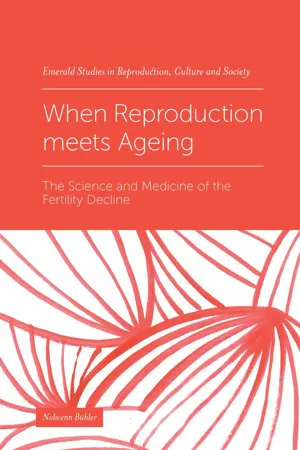Geography
Natural Increase
Natural increase refers to the difference between the number of births and the number of deaths in a population over a specific period of time. It is a key component of population growth and is often expressed as a percentage. Natural increase does not take into account migration, and is an important factor in understanding population dynamics and demographic trends.
Written by Perlego with AI-assistance
Related key terms
2 Key excerpts on "Natural Increase"
- eBook - ePub
When Reproduction meets Ageing
The Science and Medicine of the Fertility Decline
- Nolwenn Bühler(Author)
- 2021(Publication Date)
- Emerald Publishing Limited(Publisher)
This allows us to refine our understanding of what the nature of age becomes in the scientific choreography producing statistical evidence for age-related fertility decline. To understand the notion of ‘natural fertility’, we need to go back to the work of the French demographer Louis Henry and to the uncertainties raised by the post-war baby boom. An interest in the growth of population has been of scientific concern since the end of the eighteenth century and the work of Malthus (1766–1834), who advocated for a better control of population growth in order to avoid the exhaustion of the earth's resources. 4 It also originates in eugenics theories that developed in the first part of the twentieth century; both coalesced in the fear that higher social classes and races would reproduce less than the ‘dysgenic’ ones (Le Bras, 1981). In spite of this increased interest, the relationship between fertility and population growth has been difficult to establish in the sense of mathematical statistics. This relationship forms the subject of the work of two eugenic demographers and statisticians of the interwar period, the Italian Corrado Gini and the Briton Ronald Fischer, both of whom were interested in isolating the natural from the human (cultural, social) impact on fertility, that is, contraception, in order to deliberately limit births. They contributed thus in establishing a ‘racial theory of fecundity’ (Le Bras, 1981). However, the concept of ‘natural fertility’ itself is defined by Henry and gains a specific meaning and international visibility with his work. The unexpected rise in birth rate after the war, against the trend of decrease in the previous decades, questions the ability of demographers to anticipate trends in the dynamics of populations (Rosental, 2003, 2006) - eBook - ePub
Exploring Environmental Issues
An Integrated Approach
- David D. Kemp(Author)
- 2004(Publication Date)
- Routledge(Publisher)
4 Demography and World Population Growth
After reading this chapter you should be familiar with the following concepts and terms:age-specific fertility rate exponential growth population (ASFR) family planning population planning agricultural revolution fecundity population projections arithmetic progression fertility r-strategists baby boom fuelwood rate of Natural Increase birth control general fertility rate (GFR) (RNI) carrying capacity geometric progression renewable resources contraceptive pill gestation replacement fertility rate crude birth rate (CBR) immigration (RFR) crude death rate (CDR) industrial revolution replacement migration demographic transition K-strategists total fertility rate (TFR) model migration zero population growth doubling time mortality (ZPG) emigration non-renewable resources POPULATION ECOLOGY
A population is a group of individuals, usually of the same species, occupying a specific area. In the case of the human species the area involved is effectively the entire earth, but human population distribution is uneven. Although humans have developed a remarkable ability to adapt to different environmental conditions and to manipulate environments to meet their ends, some regions remain largely unpopulated. Empty spaces such as those in the Arctic and Antarctic, the deserts of Africa and Asia and the mountainous regions of all the continents, for example, are not unaffected by human activities, but in population numbers they contrast sharply with adjacent more populous regions.CARRYING CAPACITY
In these parts of the earth thinly populated by humans, the population of other species tends to be low also, reflecting the limited resources available to support life. In ecological terms, the carrying capacity of these areas is low. This concept, linking population numbers with the availability of natural resources, originated in ecology, but it is now considered too simplistic for many ecological situations. It continues to be used in conservation ecology and ecological economics, however, and in consideration of relationships between society and the environment (Turner II and Keys 2002). Carrying capacity is a measure of the maximum number of organisms that can be supported in a particular environment, and under natural conditions it represents a theoretical equilibrium state within a dynamic system. If the species in an area are below carrying capacity, for example, populations will tend to increase until some form of balance is reached with the resources available. If the carrying capacity is exceeded, because of the rapid growth in the number of organisms in the ecosystem, for example, there will be insufficient resources to support the excess population, and numbers will decline until equilibrium between the resource base and the population is re-established. Typically, the population fluctuates above and below the level of the carrying capacity before it eventually approaches equilibrium again (Figure 4.1
Learn about this page
Index pages curate the most relevant extracts from our library of academic textbooks. They’ve been created using an in-house natural language model (NLM), each adding context and meaning to key research topics.

